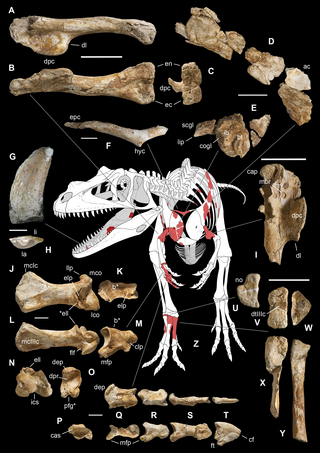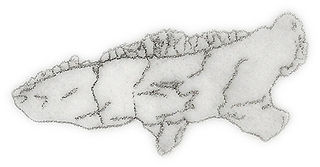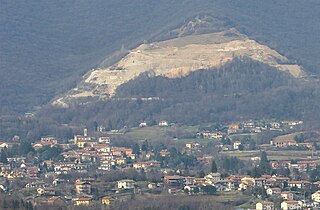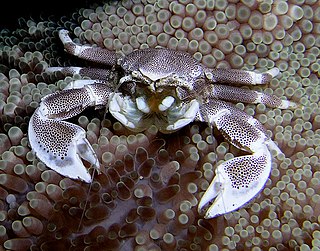
Coleoidea or Dibranchiata, is one of the two subclasses of cephalopods, containing all the various taxa popularly thought of as "soft-bodied" or "shell-less". Unlike its extant sister group Nautiloidea, whose members have a rigid outer shell for protection, the coleoids have at most an internal shell called cuttlebone or gladius that is used for buoyancy or as muscle anchorage. Some species, notably incirrate octopuses, have lost their cuttlebone altogether, while in some it has been replaced by a chitinous support structure. A unique trait of the group is the ability to edit their own RNA.

Saltriovenator is a genus of ceratosaurian dinosaur that lived during the Sinemurian stage of the Early Jurassic in what is now Italy. The type and only species is Saltriovenator zanellai; in the past, the species had been known under the informal name "saltriosaur". Although a full skeleton has not yet been discovered, Saltriovenator is thought to have been a large, bipedal carnivore similar to Ceratosaurus.

In the geologic timescale, the Sinemurian is an age and stage in the Early or Lower Jurassic Epoch or Series. It spans the time between 199.5 ±0.3 Ma and 192.9 ±0.3 Ma. The Sinemurian is preceded by the Hettangian and is followed by the Pliensbachian.

Sarcosaurus is a genus of basal neotheropod dinosaur, roughly 3.5 metres (11 ft) long. It lived in what is now England and maybe Ireland and Scotland during the Hettangian-Sinemurian stages of the Early Jurassic, about 199-196 million years ago. Sarcosaurus is one of the earliest known Jurassic theropods, and one of only a handful of theropod genera from this time period. Along with Dracoraptor hanigani it is one of the two described neotheropods from the lowermost Jurassic of the United Kingdom.
Lusitanosaurus is a genus of large basal thyreophoran dinosaur from the Sinemurian stage of Early Jurassic of Portugal. It is the second example of the group from the Lower Jurassic of Europe and it is the oldest known dinosaur from the Iberian Peninsula. It is based on a large left maxilla with teeth that was lost in the fire at Museu Nacional de História Natural e da Ciência, Lisbon, in 1978.

Tatisaurus is a genus of ornithischian dinosaur from the Early Jurassic from the Lower Lufeng Formation in Yunnan Province in China. Little is known as the remains are fragmentary. The type species is T. oehleri.

Claino con Osteno is a comune (municipality) in the Province of Como in the Italian region of Lombardy, located about 60 kilometres (37 mi) north of Milan and about 20 kilometres (12 mi) north of Como. It is a small comune on Lake Lugano, composed of a series of small frazioni (hamlets): the biggest ones have been chosen for the municipal name.

Palaeocoma is an extinct genus of brittle stars that lived during the Middle Triassic to Early Jurassic Periods. Its fossils have been found in Europe.

The Saltrio Formation is a geological formation in Italy. It dates back to the middle Sinemurian, and would have represented a pelagic or near-epicontinental environment, judging by the presence of marine fauna such as the nautiloid Cenoceras. The Fossils of the Formation were described on the late 1880s and revised on 1960s, finding first marine biota, such as Crinoids, Bivalves and other fauna related to Epicontinental basin deposits.

Corystidae is a family of crabs, in its own superfamily, Corystoidea. It includes what was once thought to be the oldest Eubrachyuran fossil, Hebertides jurassica, thought to be dating from the Bathonian ; the species was subsequently reinterpreted as being Cenozoic in age. Corystidae contains ten extant and five extinct species in eight genera:

Acanthochirana is an extinct genus of prawn that existed during the upper Jurassic period. It was named by E. Strand in 1928, and its type species is Acanthochirana cordata. They are distinguished from the related genus Aeger by the presence of teeth on the rostrum, which are absent in Aeger.

Oxynoticeratidae is a family of true ammonites included in the superfamily Psiloceratoidea.

The Galatheoidea are a superfamily of decapod crustaceans comprising the porcelain crabs and some squat lobsters. Squat lobsters within the three families of the superfamily Chirostyloidea are not closely related to the squat lobsters within the Galatheoidea. The fossil record of the superfamily extends back to the Middle Jurassic genus Palaeomunidopsis.

Coleia is an extinct genus of decapods in the group Polychelida that lived from the Late Triassic to the Late Jurassic. It was described by Broderip in 1835, and the type species is C. antiqua. A new species, C. martinlutheri, which existed during the Sinemurian of what is now Germany, was described by Günter Schweigert and Werner Ernst in 2012.

Eophasma is a genus of fossil nematodes from the Jurassic of Osteno in Lombardy, Italy. It has only one species, Eophasma jurasicum.

Ostenocaris is a Jurassic species of giant Thylacocephalan crustacean, sufficiently distinct from its relatives to be placed in its own family, Ostenocarididae. It is believed to be a bethonic animal and one of the most important necrophagus animals of its environment. Originally Interpreted as a bizarre Cirriped. Ostenocaris is the most common fossil of the formation, and the main identified thylacocephalan from the formation. In the first interpretations, the genus was shown as a filter-feeding organism, which used the cephalic sac as a burrowing organ to ensure adhesion to the substrate. Based on the presence of Coprolites associated to the genus, with abundant masses of alimentary residues in the stomach of these organisms, Ostenocaris cypriformis was probably a necrophagous organism, and the cephalic sac can be tentatively interpreted as being a burrowing organ employed during the search for food, or as an organ of locomotion with intrinsic motility.

The Rotzo Formation is a geological formation in Italy, dating to roughly between 189 and 183 million years ago and covering the Pliensbachian stage of the Jurassic Period in the Mesozoic Era. Has been traditionally classified as a Sinemurian-Pliensbachian Formation, but a large and detailed dataset of isotopic 13C and 87Sr/86Sr data, estimated the Rotzo Formation to span only over the whole Pliensbachian. The Rotzo Formation represented the Carbonate Platform, being located over the Trento Platform and surrounded by the Massone Oolite, the Fanes Piccola Encrinite, the Lombadian Basin Medolo Group and Belluno Basin Soverzene Formation, and finally towards the south, deep water deposits of the Adriatic Basin. The also Pliensbachian Aganane Formation of Morocco represents a regional equivalent, both in deposition and faunal content.
The Calcare di Sogno is a geological formation in Italy, dated to roughly between 182-169 million years ago and covering the Lower Toarcian-Late Bajocian stagess of the Jurassic Period in the Mesozoic Era. Thallatosuchian remains are known from the formation, as well fishes and other taxa.

The Moltrasio Formation also known as the Lombardische Kieselkalk Formation is a geological formation in Italy and Switzerland. This Formation mostly developed in the Lower or Middle Sinemurian stage of the Lower Jurassic, where on the Lombardian basin tectonic activity modified the current marine and terrestrial habitats. Here it developed a series of marine-related depositional settings, represented by an outcrop of 550–600 m of grey Calcarenites and Calcilutites with chert lenses and marly interbeds, that recovers the Sedrina, Moltrasio and Domaro Formations. This was mostly due to the post-Triassic crisis, that was linked locally to tectonics. The Moltrasio Formation is considered a continuation of the Sedrina Limestone and the Hettangian Albenza Formation, and was probably a shallow water succession, developed on the passive margin of the westernmost Southern Alps. It is known due to the exquisite preservation observed on the Outcrop in Osteno, where several kinds of marine biota have been recovered.

Pseudastacus is an extinct genus of decapod crustaceans that lived in the Jurassic period of Europe, and possibly the Cretaceous period of Lebanon. Many species have been assigned to it, though the placement of some species remain uncertain and others have been reassigned to different genera. The genus itself has been placed into different families by numerous authors, but is currently believed to be a member of Stenochiridae.



















